Establishment of a Two-Stage Turbocharging System Model and Analysis on Influence Rules of Key Parameters
Abstract
1. Introduction
2. Establishment of Two-Stage Turbocharging System Model
2.1. Model Hypotheses
2.2. Model Equations
2.3. Relationship between Turbine Front Pressure and Total Turbocharger Efficiency
2.4. Analysis of Key Parameters of Two-Stage Turbocharging System
2.4.1. Influence of Total Turbocharger Efficiency on Pressure Ratio and Expansion Ratio at Each Stage
2.4.2. Influence of Turbocharger Efficiency at Each Stage on Pressure Ratio and Expansion Ratio at Each Stage
2.4.3. Influence of Front-Rear Temperature Difference of High-Pressure Stage Turbine on Pressure Ratio and Expansion Ratio at Each Stage
2.5. Optimization of Pressure Ratio Distribution Principle of Two-Stage Turbocharger
2.6. Influence Analysis of Two-Stage Turbocharging Key Parameters with the Optimal Pressure Ratio Distribution of Two-Stage Turbocharger
2.6.1. Influence Relation between the Total Turbocharger Efficiency and the Efficiency of Turbocharger at Each Stage
2.6.2. Relationship between Total Turbocharger Efficiency and Front–Rear Temperature Difference of High-Pressure Stage Turbine
2.7. Optimization of Expansion Ratio Distribution Principle of the Two-stage Turbocharger
2.8. Calculation of Geometric Equivalent Circulation Cross Section of Two-Stage Turbine
3. Model Validation
Test Platform and Test Device
4. Conclusions
- (1)
- According to the energy balance relationship between the compressor and the turbine of the two-stage turbocharging system, a method for optimizing the key parameters of the two-stage turbocharger was summarized, and the theoretical constraint equations for the optimal distribution principle of the pressure ratio and expansion ratio of the two-stage turbocharger was proposed, i.e.,
- (2)
- Under the condition that the total pressure ratio, the total expansion ratio, the high-pressure turbocharger efficiency, and the front–rear temperature difference of the turbine are constant, the pressure ratio of the low-pressure stage turbocharger increases as the total turbocharger efficiency increases, while the pressure ratio of the high-pressure stage turbocharger decreases as the total turbocharger efficiency increases.
- (3)
- When the total turbocharger efficiency, the high-pressure stage turbocharger efficiency, and the front-rear temperature difference of high-pressure stage turbine are constant, if the low-pressure stage turbocharger efficiency increases, the pressure ratio and expansion ratio of the low-pressure stage turbocharger increase and those of the high-pressure stage turbocharger are lowered.
- (4)
- When the total pressure ratio, the total expansion ratio, and the efficiency of the turbocharger at each stage remain unchanged, both the pressure ratio and the expansion ratio of the high-pressure stage turbocharger increase with the increase of the front–rear temperature difference of the high-pressure stage turbine, while both the pressure ratio and the expansion ratio of the low-pressure stage turbocharger decrease as the front–rear temperature difference of the high-pressure stage turbine increases.
Author Contributions
Funding
Conflicts of Interest
Abbreviations:
| a | Theoretical air volume |
| be | Brake specific fuel consumption (g/(kW·h)) |
| bi | Indicated specific fuel consumption (g/(kW·h)) |
| D | Piston diameter (mm) |
| FT | Geometric equivalent circulation area of turbine |
| Hu | Calorific value of diesel (J/kg) |
| k | Air isentropic exponent |
| kT | Exhaust gas isentropic exponent |
| n | Engine speed (rpm) |
| ζT | Coefficient of heat utilization |
| ϕas | Total excess air ratio |
| ϕa | Excess air ratio |
| ϕc | Volumetric efficiency |
| ϕs | Scavenging coefficient |
| β0 | Theoretical coefficient of molecular change |
| Ta | Standard atmosphere pressure (K) |
| TT | Temperature ahead of turbine (K) |
| TS | Aero-engine inlet temperature (K) |
| T0 | Compressor inlet temperature (K) |
| PS | Intake manifold pressure (MPa) |
| PT | Turbine inlet pressure (MPa) |
| PT0 | Turbine outlet pressure (MPa) |
| PTh | Pressure ahead of low-pressure stage turbine (MPa) |
| PL | Outlet pressure of low-pressure stage compressor (MPa) |
| R | Air gas constant |
| RT | Exhaust gas constant |
| TWL | Temperature ahead of low-pressure stage turbine (K) |
| qmb | Compressor flow (kg/h) |
| qmt | Turbine flow (kg/h) |
| µT | Flow coefficient of the equivalent circulation cross-section of the turbine |
| (µcp)T | Molar heat capacity at constant pressure at the average gas temperature of at the turbine inlet (J/(mol·K)) |
| (µcp)a | Molar heat capacity at constant pressure at the air temperature of in the diesel intake pipe (J/(mol·K)) |
| UT | Turbine peripheral speed (m/s) |
| Vm | Piston mean speed (m/s) |
| ηbL | Low-pressure stage turbocharger efficiency |
| ηTbk | High-pressure stage turbocharger efficiency |
| ηTb | Total turbocharger efficiency |
| ηm | Mechanical efficiency |
| ψTH | Effective equivalent circulation area of high-pressure stage turbine (cm2) |
| πT | Expansion ratio |
| πTeq | Corrected expansion ratio |
| ψTL | Effective equivalent circulation area of low-pressure stage turbine (cm2) |
| Expansion ratio constraint equation | |
| Pressure ratio constraint equation |
References
- Li, C.; Wang, Y.; Jia, B.; Roskilly, A.P. Application of Miller Cycle with turbocharger and ethanol to reduce NOx and particulates emissions from diesel engine—A numerical approach with model validations. Appl. Eng. 2019. [Google Scholar] [CrossRef]
- Benson, R.S. Two—Stage Turbocharging of Diesel Engines: A Matching Procedure and Experimental Investigation; SAE 1974-09-12; SAE International: Warrendale, PA, USA, 1974. [Google Scholar]
- Bahiuddin, I.; Mazlan, S.A.; Imaduddin, F. A new control-oriented transient model ofvariable geometry turbometry. Energy 2017, 125, 297–312. [Google Scholar] [CrossRef]
- Chiong, M.S.; Rajoo, S.; Romagnoli, A.; Costall, A.W.; Martinez-Botas, R.F. Non-adiabatic pressure loss boundary condition for modelling turbocharger turbine pulsating flow. Energy Convers. Manag. 2015, 93, 267–281. [Google Scholar] [CrossRef][Green Version]
- Tancrez, M.; Galindo, J.; Guardiola, C.; Fajardo, P.; Varnier, O. Turbine adapted maps for turbocharger engine matching. Exp. Therm. Fluid Sci. 2011, 35, 146–153. [Google Scholar] [CrossRef]
- Galindo, J.; Serrano, J.R.; Climent, H.; Varnier, O. Impact of two-stage turbocharging architectures on pumping losses of automotive engines based on an analytical model. Energy Convers. Manag. 2010, 51, 1958–1969. [Google Scholar] [CrossRef]
- Zheng, Z.; Feng, H.; Mao, B.; Liu, H.; Yao, M. A theoretical and experimental study on the effects of parameters of two-stage turbocharging system on performance of a heavy-duty diesel engine. Appl. Therm. Eng. 2018, 129, 822–832. [Google Scholar] [CrossRef]
- Yang, M.; Gu, Y.; Deng, K.; Yang, Z.; Liu, S. Influence of altitude on two-stage turbocharging system in a heavy-duty diesel engine based on analysis of available flow energy. Appl. Therm. Eng. 2018, 129, 12–21. [Google Scholar] [CrossRef]
- Liu, Y.; Zhuge, W.; Zhang, Y.; Zhang, S.; Zhang, J.; Huo, X. A Matching Method for Two-Stage Turbocharging System; Volume 1B: Marine; Microturbines, Turbochargers and small Turbomachines; Steam Turbines. In Proceedings of the ASME Turbo Expo 2014: Turbine Technical Conference and Exposition, Düsseldorf, Germany, 16–20 June 2014. [Google Scholar] [CrossRef]
- Sanaye, S.; Ghadikolaee, S.S.; Moghadam, S.A.A. A new method for optimum selection of two-stage turbocharger for heavy duty diesel engine. Int. J. Heavy Veh. Syst. 2015, 22, 42. [Google Scholar] [CrossRef]
- Li, H.; Zhang, G.; Zhang, H.; Shi, L.; Yang, M.; Deng, K. Equivalent matching model of a regulated two-stage turbocharging system for the plateau adaptability. Proc. Inst. Mech. Eng. Part D J. Automob. Eng. 2016, 230, 1654–1669. [Google Scholar] [CrossRef]
- Zhu, Z.; Zhang, F.; Li, C.; Wu, T.; Han, K.; Lv, J.; Li, Y.; Xiao, X. Genetic algorithm optimization applied to the fuel supply parameters of diesel engines working at plateau. Appl. Energy 2015, 157, 789–797. [Google Scholar]
- Shi, X.; Wang, T.; Ma, C. Simulations of the diesel engine performance with a two-stage sequential turbocharging system at different altitudes. Proc. Inst. Mech. Eng. Part D J. Automob. Eng. 2014, 228, 1718–1726. [Google Scholar] [CrossRef]
- De Bellis, V.; Marelli, S.; Bozza, F.; Capobianco, M. 1D Simulation and Experimental Analysis of a Turbocharger Turbine for Automotive Engines under Steady and Unsteady Flow Conditions. Energy Procedia 2014, 45, 909–918. [Google Scholar] [CrossRef]
- Plianos, A.; Stobart, R. Modeling and Control of Diesel Engines Equipped with a Two-Stage Turbo-System; SAE Paper, 2008-01-1018; SAE: Warrendale, PA, USA, 2008. [Google Scholar]
- Romagnoli, A.; Manivannan, A.; Rajoo, S.; Chiong, M.S.; Feneley, A.; Pesiridis, A.; Martinez-Botas, R.F. A review of heat transfer in turbochargers. Renew. Sustain. Energy Rev. 2017, 79, 1442–1460. [Google Scholar] [CrossRef]
- Chuepeng, S.; Saipom, S. Lubricant thermo-viscosity effects on turbocharger performance at low engine load. Appl. Therm. Eng. 2018, 139, 334–340. [Google Scholar] [CrossRef]
- Ding, Z.; Zhuge, W.; Zhang, Y.; Chen, H.; Martinez-Botas, R.; Yang, M. A one-dimensional unsteady performance model for turbocharger turbines. Energy 2017, 132, 341–355. [Google Scholar] [CrossRef]
- Shi, Z.; Dong, J.; Zhang, M.; Zhang, L. Solidification characteristics and hot tearing susceptibility of Ni-based superalloys for turbocharger turbine wheel. Trans. Nonferrous Met. Soc. China 2014, 24, 2737–2751. [Google Scholar] [CrossRef]
- Jiao, K.; Sun, H.; Li, X.; Wu, H.; Krivitzky, E.; Schram, T.; Larosiliere, L.M. Numerical simulation of air flow through turbocharger compressors with dual volute design. Appl. Energy 2009, 86, 2494–2506. [Google Scholar] [CrossRef]
- Uchida, H.; Kashimoto, A.; Iwakiri, Y. Development of wide flow range compressor with variable inlet guide vane. RD Rev. Toyota CRDL 2016, 41, 9–14. [Google Scholar]
- Lei, Y.; Zhou, D.S.; Zhang, H.G. Investigation on performance of a compression-ignition engine with pressure-wave supercharger. Energy 2010, 35, 85–93. [Google Scholar] [CrossRef]
- Novotný, P.; Škara, P.; Hliník, J. The effective computational model of the hydrodynamics journal floating ring bearing for simulations of long transient regimes of turbocharger rotor dynamics. Int. J. Mech. Sci. 2018, 148, 611–619. [Google Scholar] [CrossRef]
- Padzillah, M.H.; Rajoo, S.; Yang, M.; Martinez-Botas, R.F. Influence of pulsating flow frequencies towards the flow angle distributions of an automotive turbocharger mixed-flow turbine. Energy Convers. Manag. 2015, 98, 449–462. [Google Scholar] [CrossRef]
- Aymanns, R.; Scharf, J.; Uhlmann, T.; Lückmann, D. A revision of quasi steady modelling of turbocharger turbines in the simulation of pulse charged engines. Energy Conversion and Management. In Proceedings of the 16th Supercharging Conference, Dresden, Germany, 29–30 September 2011. [Google Scholar]
- Jiang, S.; Wang, S.; Jin, X.; Yu, Y. Optimum compressor cylinder volume ratio for two-stage compression air source heat pump systems. Int. J. Refrig. 2016, 67, 77–89. [Google Scholar] [CrossRef]
- Haipeng, Y.; Kang, S.; Hui, X. Research on air system optimization control of electrically assisted turbocharged diesel engine based on model prediction. Chin. Intern. Combust. Engine Eng. 2018, 39, 39–46. [Google Scholar]
- Ghazikhani, M.; Davarpanah, M.; Shaegh, S.M. An experimental study on the effects of different opening ranges of waste-gate on the exhaust soot emission of a turbo-charged DI diesel engine. Energy Convers. Manag. 2008, 49, 2563–2569. [Google Scholar]
- Grönman, A.; Sallinen, P.; Honkatukia, J.; Backman, J.; Uusitalo, A. Design and experiments of two-stage intercooled electrically assisted turbocharger. Energy Convers. Manag. 2016, 111, 115–124. [Google Scholar] [CrossRef]
- Ono, Y.; Shiraishi, K.; Sakamoto, K.; Ito, Y. Development of new turbocharger technologies for energy efficiency and low emissions. In Proceedings of the 10th International Conference on Turbochargers and Turbocharging, London, UK, 15–16 May 2012; pp. 365–374. [Google Scholar] [CrossRef]



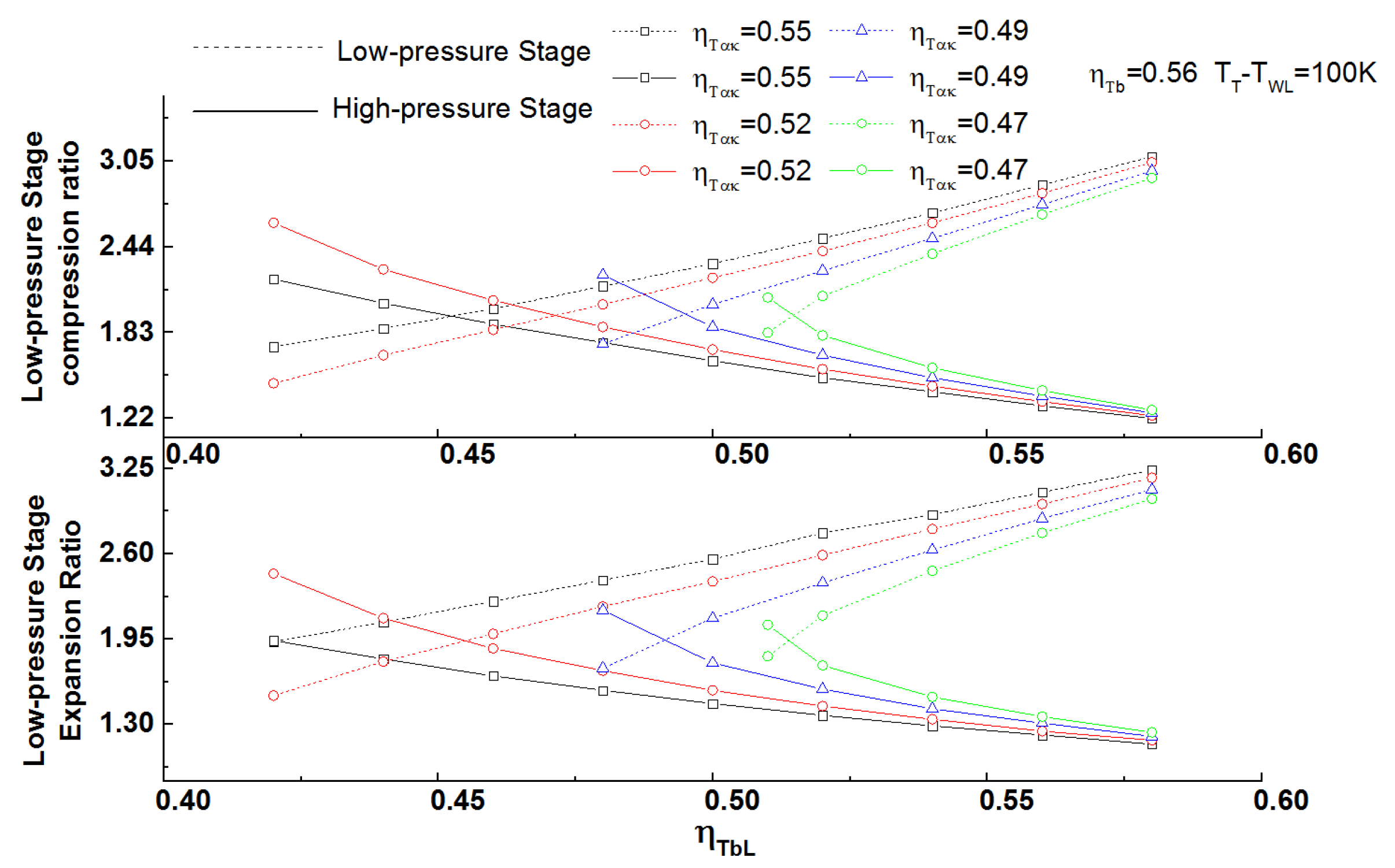
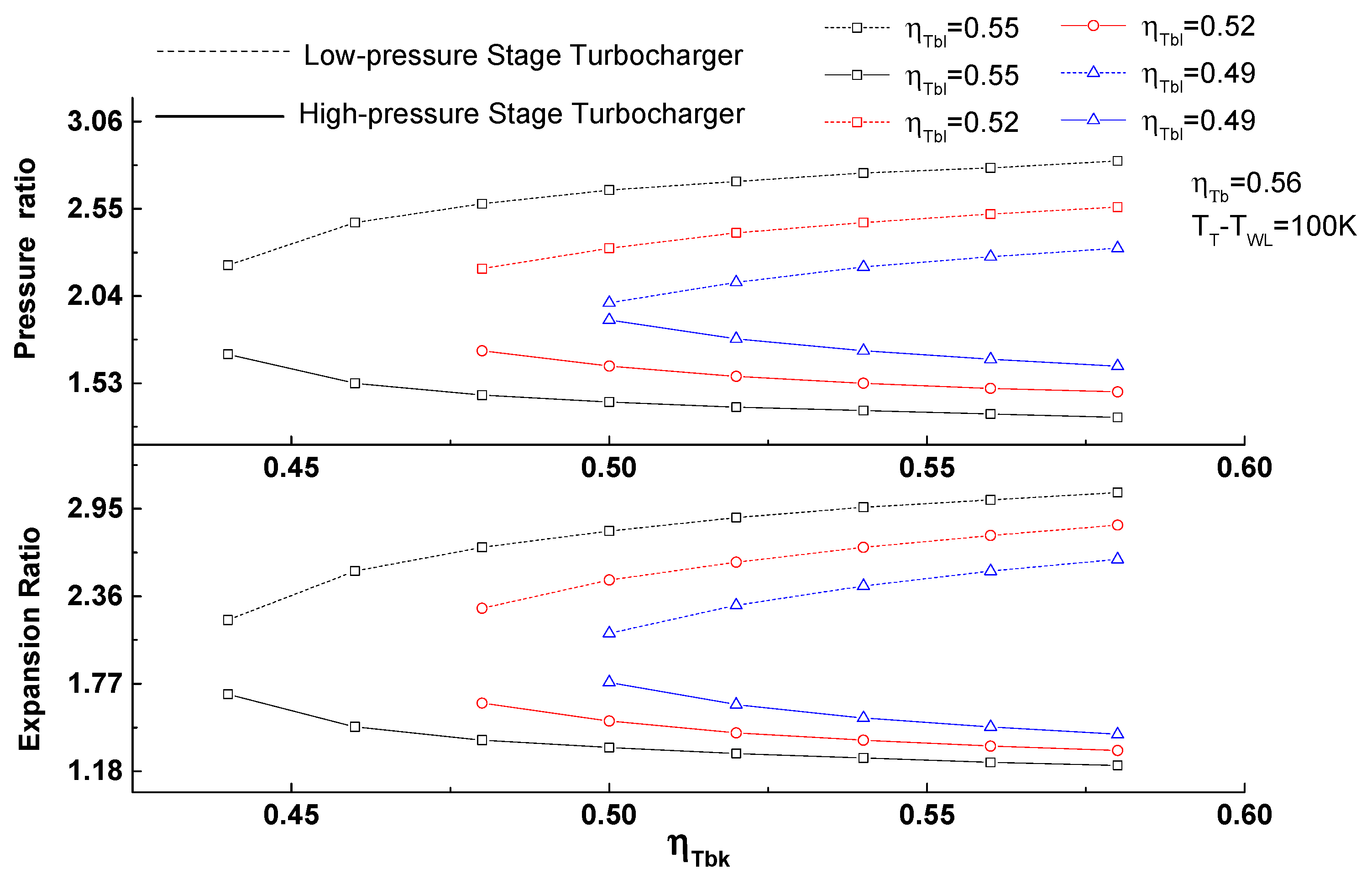
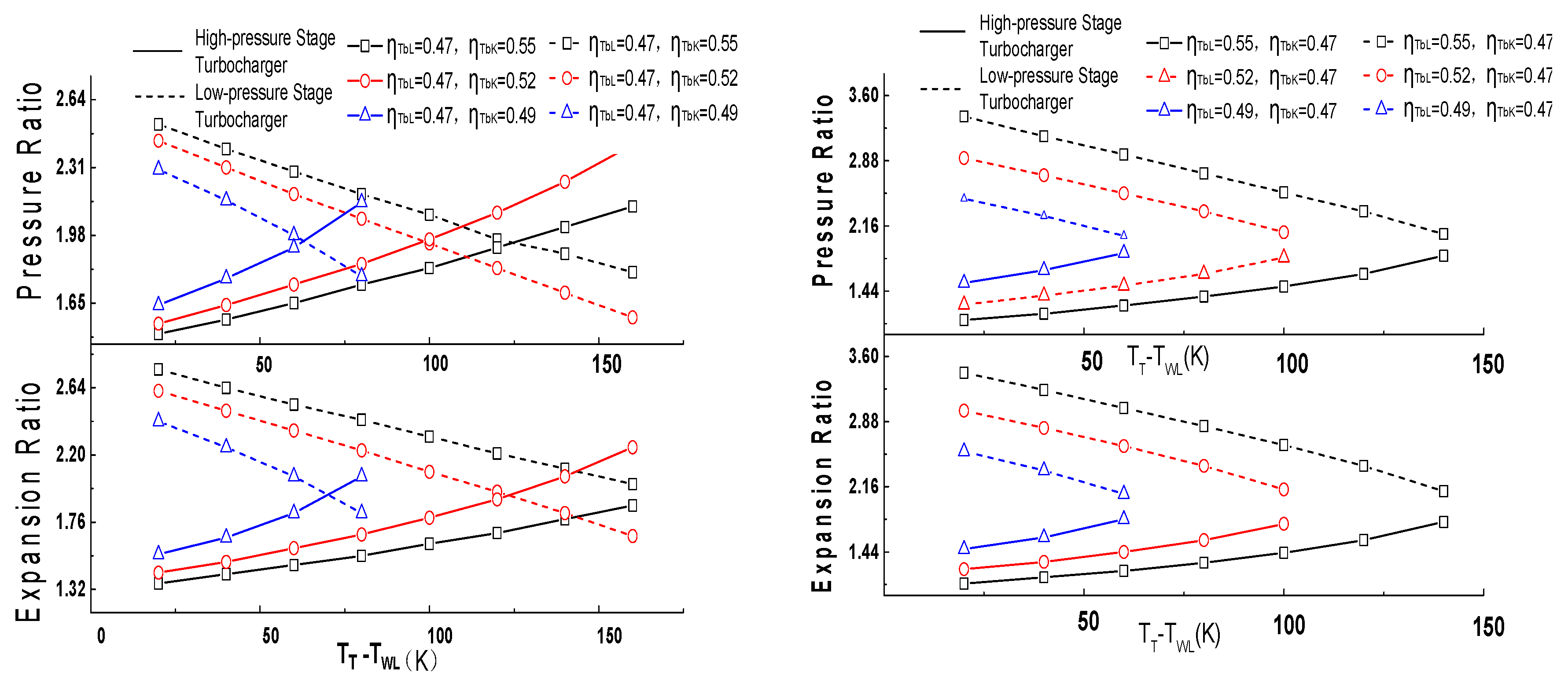
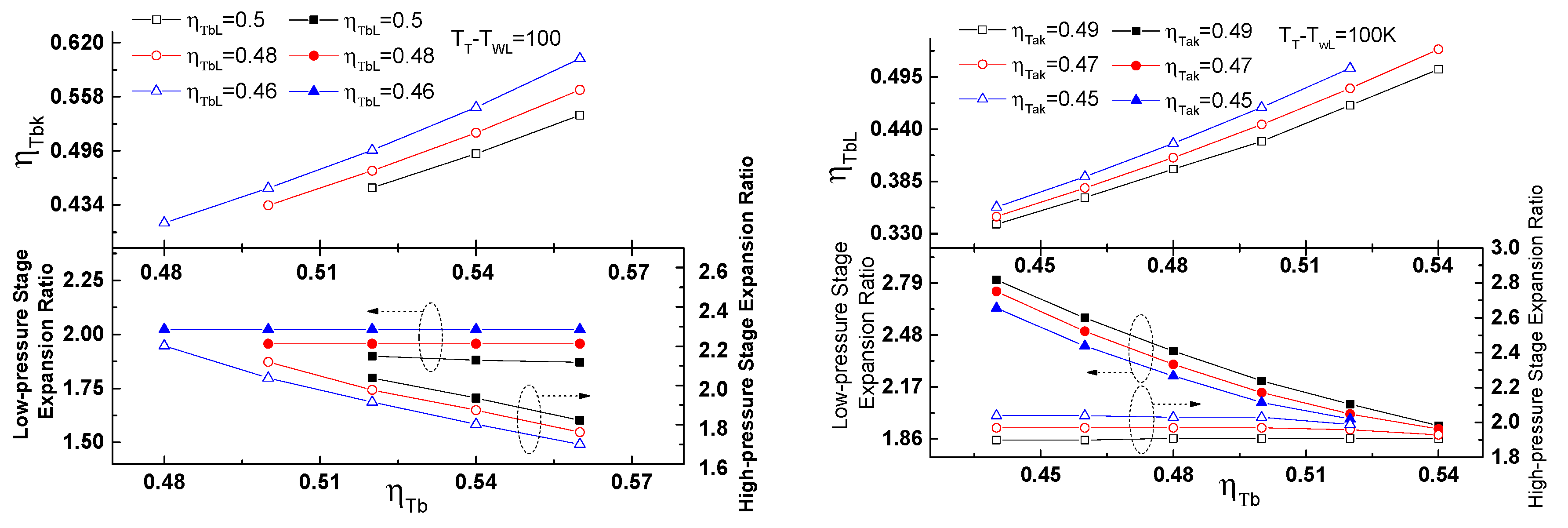
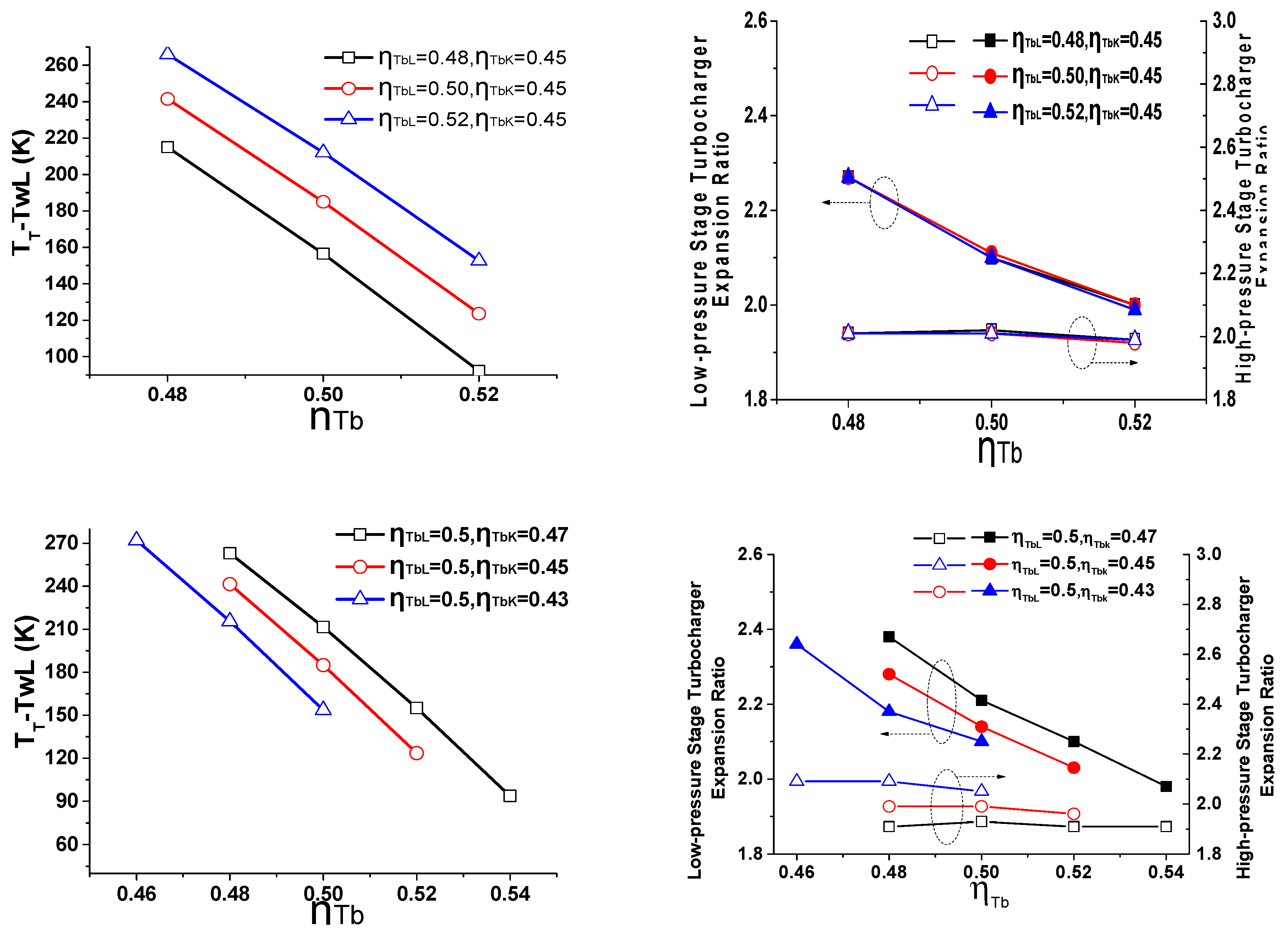

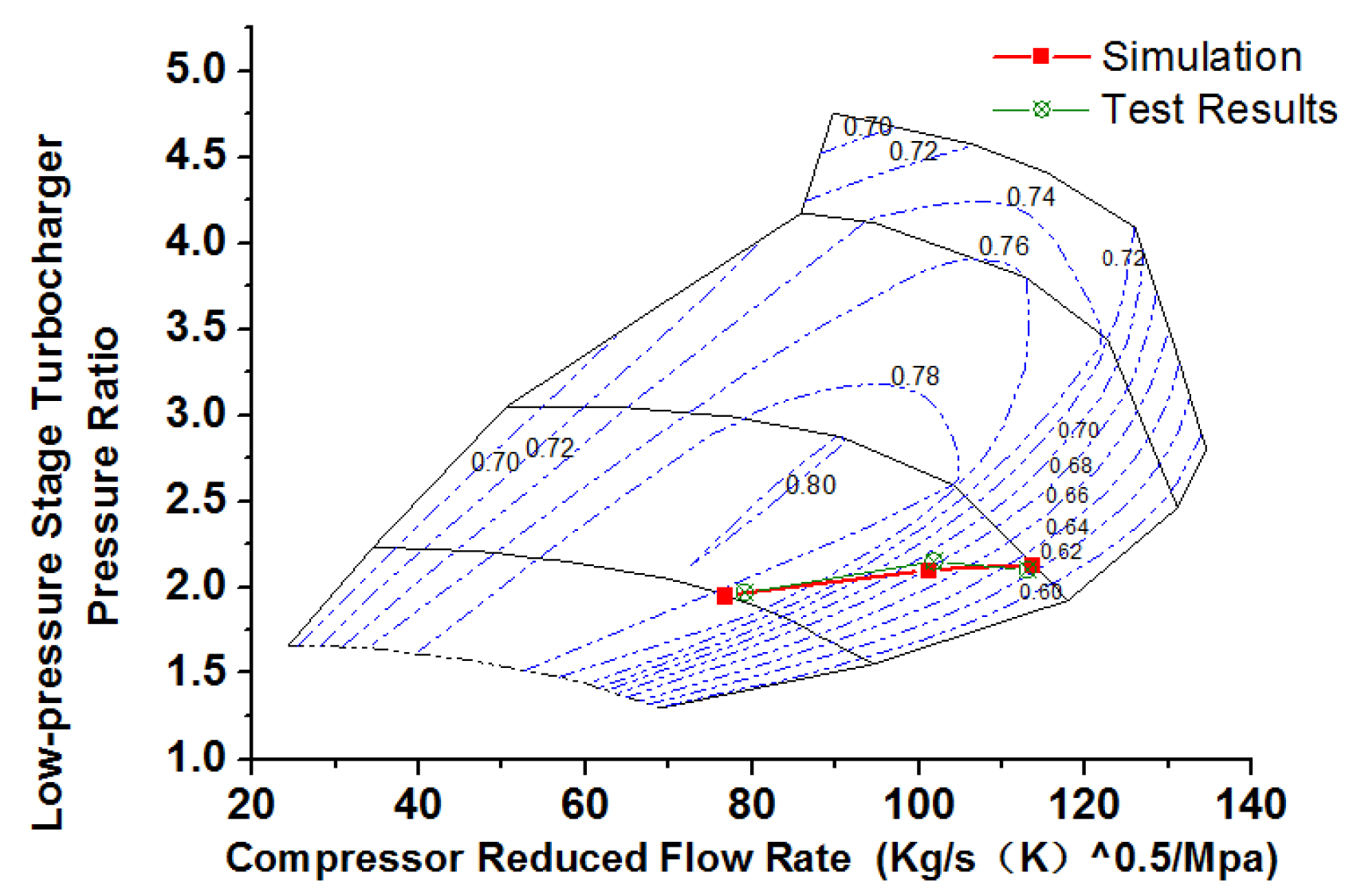
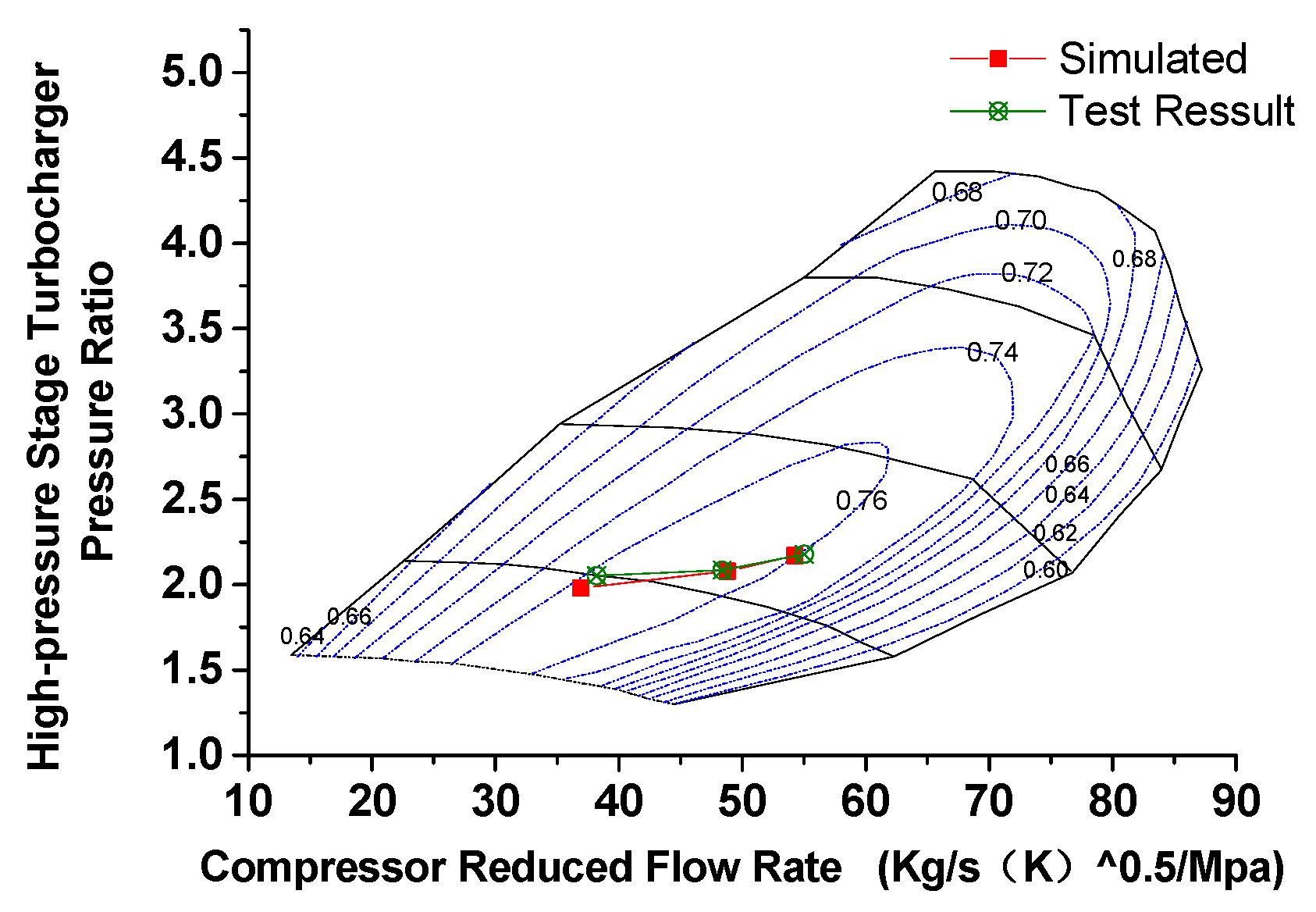
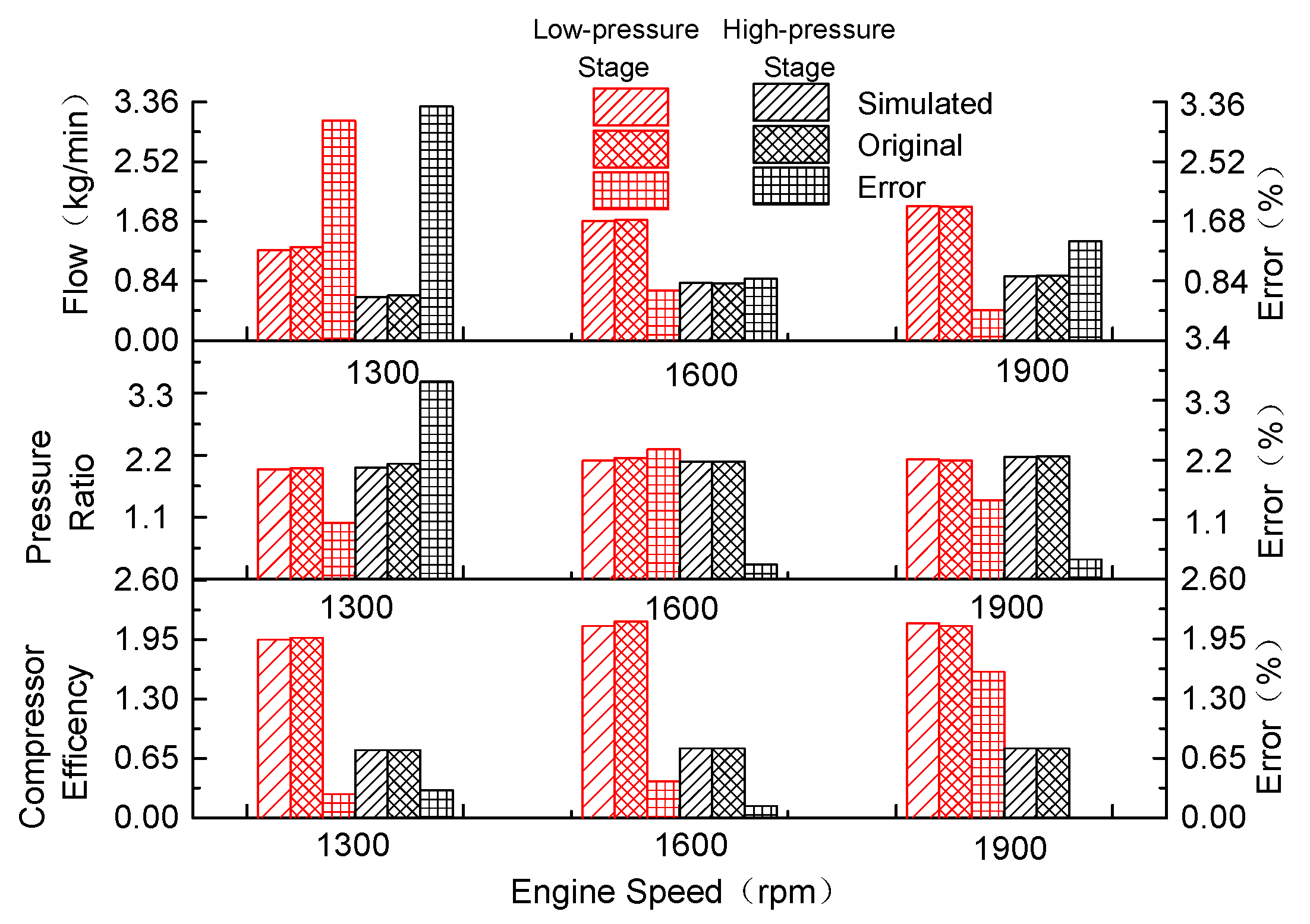
| Item | Parameter |
|---|---|
| Cylinder diameter (mm) | 126 |
| Stroke (mm) | 155 |
| Displacement (L) | 11.596 |
| Compression ratio | 17:1 |
| Intake swirl ratio | 1.2 |
| Combustion chamber | ω type |
| Intake type | Charging with inter-cooling |
| Number of holes × aperture × cone angle | 8 × 0.217 × 143 |
| Max. rotation speed (rpm) | 2200 |
| Max. power (kW) | 353 (2100 rpm) |
| Max. torque (Nm) | 1970 (1200–1500 rpm) |
| Max. explosion pressure (MPa) | 16.5 |
| Input Parameter | 1300 rpm—100% Load | 1600 rpm—100% Load | 1900 rpm—100% Load |
|---|---|---|---|
| Vm (m/s) | 6.717 | 8.267 | 9.82 |
| Pme (MPa) | 0.2165 | 0.203 | 0.183 |
| be (kg/kW·h) | 0.198 | 0.221 | 0.232 |
| Ts (K) | 330 | 330 | 340 |
| Pe (kW) | 271.97 | 313.96 | 336.43 |
| TT (K) | 811 | 879 | 973 |
| PT0 (MPa) | 0.1065 | 0.11 | 0.113 |
| Calculation Result | 1300 rpm—100% Load | 1600 rpm—100% Load | 1900 rpm—100% Load |
|---|---|---|---|
| qmb (kg/h) | 1458 | 1924 | 2129 |
| Pb (MPa) | 0.376 | 0.435 | 0.447 |
| PT (MPa) | 0.379 | 0.446 | 0.449 |
| Low-pressure stage turbocharge ratio | 1.95 | 2.1 | 2.13 |
| High-pressure stage turbocharge ratio | 1.95 | 2.1 | 2.12 |
| Low-pressure stage expansion ratio | 1.9 | 2.05 | 2.06 |
| High-pressure stage expansion ratio | 1.87 | 1.97 | 1.98 |
| Calculation Result | 1300 rpm—100% Load | 1600 rpm—100% Load | 1900 rpm—100% Load |
|---|---|---|---|
| Geometric equivalent circulation area of the low-pressure stage turbine (cm2) | 23.67 | 30.13 | 38.49 |
| Geometric equivalent circulation area of the high-pressure stage turbine (cm2) | 13.79 | 16.43 | 19.65 |
| Turbocharger Provider | Turbocharger Location | Compressor End Model | Turbine End Model |
|---|---|---|---|
| Holset | Low-pressure stage turbocharger | B108N66RAH | HX50-S22W11 |
| High-pressure stage turbocharger | B85J71GL | C76N79FHB13UE |
| Equipment Name | Model | Specifications | Accuracy | Manufacturer |
|---|---|---|---|---|
| Thermal-film flowmeter | TOCEIL-20N125 | 0~1800 kg/h | 0.1 kg/h | Shanghai ToCeiL |
| Fuel consumption meter | CMFG010 | 0~60 Kg/h | ±0.12% | Shanghai ToCeiL |
| Electric eddy current dynamometer | CW440D | 440 kW 2800 N·m/1000–1500 rpm 6800 rpm | ±0.4% FS ±1 rpm | CAMA (Luoyang) |
| Pressure sensor | CYYZ11-Z-46-V5-07-B-G | −100–500 KPa | 0.1% FS | Beijing Star |
| Temperature sensor | WRNK-191 | 0–600 °C | 1% FS | Shanghai Yijia |
| Photoelectric encoder | E6C2-CWZ3E | 0~6000 rpm | 100 kHz | OMRON |
| Acquisition card | NI-USB6353 | −10 v~10 v | 16-bit resolution | National Instruments |
© 2020 by the authors. Licensee MDPI, Basel, Switzerland. This article is an open access article distributed under the terms and conditions of the Creative Commons Attribution (CC BY) license (http://creativecommons.org/licenses/by/4.0/).
Share and Cite
Tian, W.; Du, D.; Li, J.; Han, Z.; Yu, W. Establishment of a Two-Stage Turbocharging System Model and Analysis on Influence Rules of Key Parameters. Energies 2020, 13, 1953. https://doi.org/10.3390/en13081953
Tian W, Du D, Li J, Han Z, Yu W. Establishment of a Two-Stage Turbocharging System Model and Analysis on Influence Rules of Key Parameters. Energies. 2020; 13(8):1953. https://doi.org/10.3390/en13081953
Chicago/Turabian StyleTian, Wei, Defeng Du, Juntong Li, Zhiqiang Han, and Wenbin Yu. 2020. "Establishment of a Two-Stage Turbocharging System Model and Analysis on Influence Rules of Key Parameters" Energies 13, no. 8: 1953. https://doi.org/10.3390/en13081953
APA StyleTian, W., Du, D., Li, J., Han, Z., & Yu, W. (2020). Establishment of a Two-Stage Turbocharging System Model and Analysis on Influence Rules of Key Parameters. Energies, 13(8), 1953. https://doi.org/10.3390/en13081953





